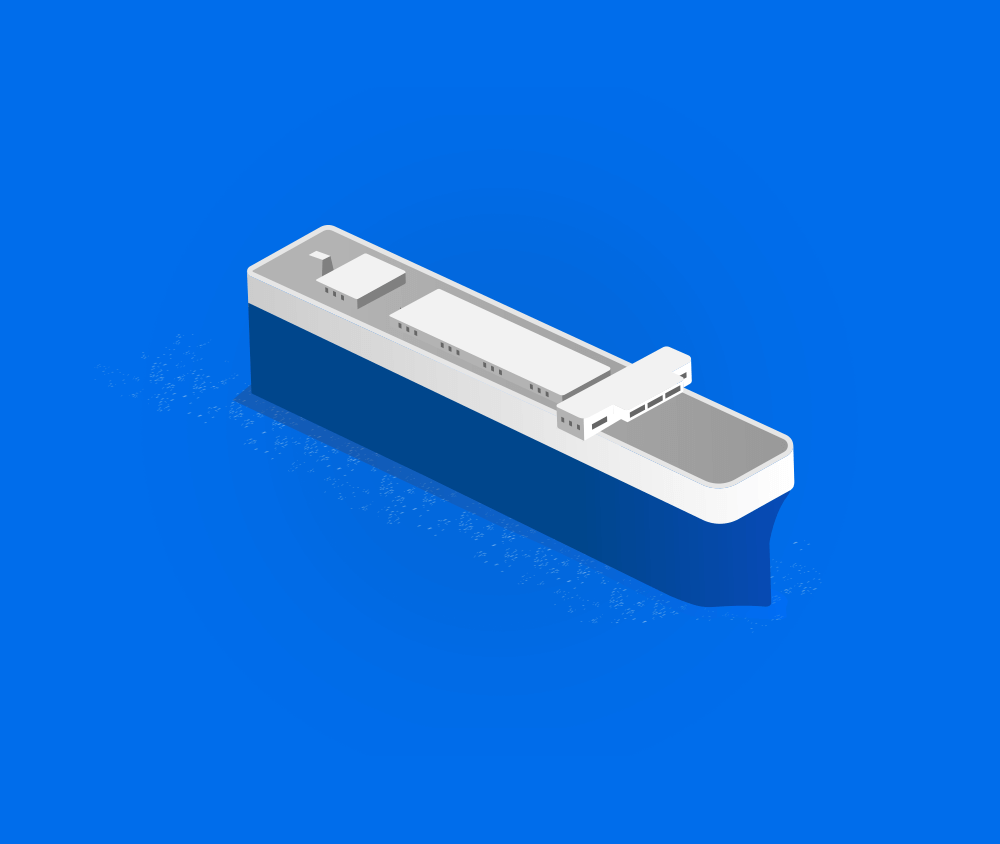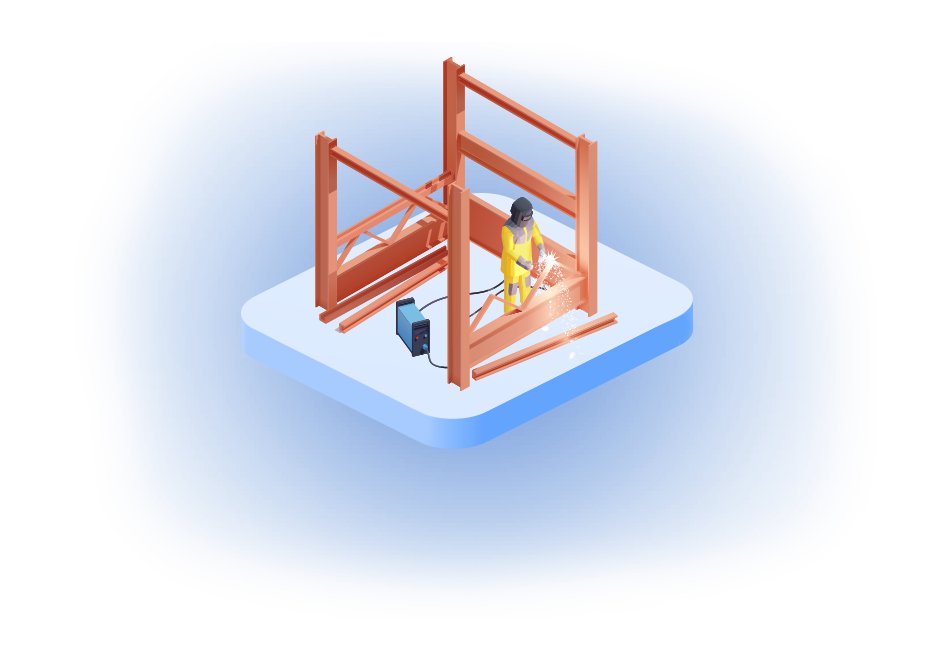Our value chain
-
Steel production
for shipbuilding
Shipbuilding process
Steel production
for shipbuildingThe shipbuilding process requires a large inflow of high-emission materials such as steel. Steel is produced from iron ore, a compound of iron and other minerals. The process begins with the heating and melting of iron ore in a furnace. Impurities are removed and alloying elements are added to create different steel grades. Two primary methods are used: basic oxygen steelmaking, using liquid pig-iron and scrap steel, and electric arc furnace steelmaking, using scrap steel or direct reduced iron. The result is strong, versatile steel used as input in our shipbuilding process.
-
Shipyard

Shipbuilding process
Shipyard
The construction of a RoRo vessel is a fascinating journey from design to delivery. It commences with pre-contract work, involving detailed design and cost estimation. Upon contract signing, general project management ensures smooth execution, with site supervision maintaining safety and addressing non-compliance. The hull structure, the ship’s backbone, is constructed using cut, shaped, and welded steel plates. Simultaneously, equipment storage is managed, and electrical equipment is installed. Machinery installation follows, and the vessel undergoes rigorous testing and dock trials. After successful trials, fuel oil, lub oil, and fresh water are taken over, and tanks are closed. Manuals, tools, and spares are delivered, and owner-supplied equipment is installed. The process culminates in the delivery of the vessel, symbolizing the successful marriage of engineering expertise and skilled craftsmanship.
-
Daily operations

Port and own operations incl maintenance
Daily operations
Crewing:
All crew need to be medical fit prior to joining any vessels, the crew will undergo a medical examination, undergo training needed for planned position. Crewing department will prepare documentation for processing of contracts, process contract with national administration, arrange for travel via travel agent and port agent.At sea, the crew perform various watch keeping duties at bridge and in the engine room, maintenance work on the vessel, participates in preparations for cargo operation inspections as well as safety drills.
In ports, the crew perform cargo and engine watch keeping duties, perform maintenance that can only be performed when in port, bunkering provisioning, shore-leave for off-duty crew
Trade planning:
Trade planning is essential for coordinating vessel schedules, cargo allocations, and adjusting them as needed. Our trade planners orchestrate optimal voyages, ensuring efficient vessel utilization and timely delivery of our core product. With daily market interactions our trade planners are also an important source of commercial insight, enabling us to adapt swiftly to changing conditions and maintain our competitive edge. With teams based in Oslo, Tokyo, and Jacksonville, we cover 11 trades globally, facilitating effective workflow and proximity to key markets. This pivotal role guarantees seamless operations at Höegh Autoliners.Cargo Planning:
A fully loaded PCTC-vessel carries several thousand units on board. These units are loaded and discharged in multiple ports and must be loaded on a suitable deck based on its size, weight, and destination. The Cargo Planner’s task is to maximize the vessel’s space, and plan effective and safe cargo operations. You could say that the Cargo Planner task is to solve the Tetris-game based on both shape and color. All this is done in close cooperation with Trade Planner, Stevedores and Vessel Command. -
Ports

Port and own operations incl maintenance
Ports
The ships call at ports for cargo operations, bunkering, victualling, and maintenance. Ports are often divided into terminals that cater to specific activities. For example, automotive cargo, containers, or bulk commodities are typically handled in separate locations due to differing handling requirements.
Höegh Autoliners will call at terminals that cater to its target cargo. These facilities are either privately held or government entities and often have separate arrangements with cargo shippers and receivers. The terminals will consolidate the cargo for shipment.
The ships berth alongside the quay and prepare for operations. Ramps are lowered, cargo decks adjusted, and ramp ways readied. Contractors perform tasks such as tying up the ship, loading and discharging cargo, (un)lashing cargo, tally work, and making stowage plans. The ship’s Officers supervise the work and ensure it meets expected standards.
Different entities handle bunkering the ship, victualling, providing supplies, and various maintenance tasks. Pilots, customs officials, security personnel, quarantine and border control are examples of other entities involved.
-
Technical management
and maintenance
Port and own operations incl maintenance
Technical management
and maintenanceTechnical management:
Technical management is a key component of ship management which Hoegh Autoliners Management AS (HAM AS) has been authorized to operate by the Norwegian Maritime Authority (NMA) under the International Safety Management (ISM) Code.The ISM Code is the International Maritime Organization (IMO) standard for the safe management and operation of ships at sea and focuses on ensuring safety at sea and preventing damage to property, personnel and environment.
The key aspects of technical management are:
- Technical operations: This includes the certification of vessels, ensuring compliance with legal requirements and documentation and day-to-day maintenance. Maintenance is either planned, condition-based or unplanned. Maintenance frequency varies, depending on equipment or machinery criticality. Each vessel undergoes a major maintenance stop every 5 years, i.e., drydocking. The company has an automated Planned Maintenance System (PMS) which triggers these maintenance routines when due.
- Vessel Procurement: Managing day-to-day vessel operations, maintenance, and repairs require procurement of spares, consumables or obtaining specialized external services.
- Health, Safety, Security, Environment and Quality (HSSEQ): This involves overseeing the HSSEQ matters onboard each vessel and verifying that they continuously comply with the ISM Code.”
Dry-docking/maintenance:
The dry-docking procedure for a RoRo vessel begins with its arrival at the shipyard. The vessel enters the dry-dock, which is then drained. The cables are ranged on the dock bottom for secure mooring. The hull undergoes washing, blasting, and painting to ensure efficient operations for the next five years. All ship-side sea valves are inspected and overhauled, and necessary repairs and maintenance are carried out on engines, pumps, tanks, and cargo spaces. Before completion, it is ensured that all waste, scrap material, bilge water and sludge are discharged and that the vessel has been properly cleaned. Machinery and equipment are also properly tested prior leaving yard or sailing. After all work is completed, the dock is flooded, and the vessel departs. Sea trials are conducted to confirm the operation of all ship’s machinery. Upon completion of sea trials, the vessel is commissioned back into service. -
Customers

Port and own operations incl maintenance
Customers
At Höegh Autoliners, we offer a comprehensive range of services to our diverse customers. Our fleet, designed for maximum flexibility, caters to a wide array of cargo, from brand-new vehicles to heavy construction equipment.
Our commitment to innovation and customer satisfaction has positioned us as a leader in the automotive transport industry. Car manufacturers worldwide trust us for the transportation of their brand-new vehicles on our RoRo shipping vessels, which function like mobile parking structures, ensuring the secure anchoring of cars to their decks.
Our Pure Car and Truck Carriers (PCTC) are the ultimate solution for transporting large rolling units, including trucks, buses, trailers, motorhomes, and caravans. The wide ramps of our PCTC vessels facilitate easy manoeuvring and loading of wide and long units.
We also specialize in transporting mining equipment, agricultural machinery, and machine tools, understanding the unique requirements and challenges involved. Our modern rolltrailers, equipped with rails, ensure safe and secure transportation of diverse cargo sizes throughout the entire voyage. Choose Höegh Autoliners for efficient, safe, and innovative transport solutions.
-
Ship recycling

Ship recycling
Ship recycling
The recycling of a vessel is a meticulous process that begins with the pre-cleaning process. This involves the removal of all potentially hazardous materials and substances from the ship to ensure safety.
Next is the demolition process, where the ship is systematically dismantled. This starts with the removal of non-structural components, followed by the cutting down of the ship’s structure to obtain steel.
The waste handling process is a crucial part of recycling. All materials and equipment are reused in other forms, while hazardous materials are safely disposed of by authorized agencies.
Finally, the documentation process ensures that all stages of the recycling process are recorded and monitored for compliance with international standards. This includes the tracking of waste disposal and the final destination of recycled materials. This rigorous process ensures the safe and environmentally sound recycling of vessels.